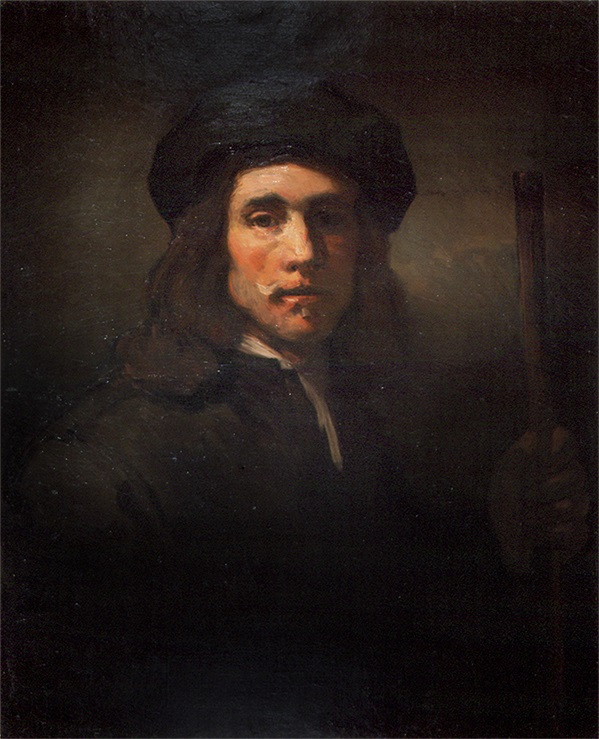Robert Henri
"Study After Rembrandt"
Oil on Canvas: 32 x 25 1/2 Inches
Signed Lower Left
The next time you’re mingling at a party or at any gathering of culturally-minded individuals, ask them to name five American artists quickly, much as they might rattle off the names of the latest movie, automobile or computer. Chances are, you’ll get no name at all, or ones like Picasso, even Monet. No, that wouldn’t happen, not in circles of educated Americans. Oh yes it can, dear reader. And if my scenario rings a bell in your memory, why not admit openly that we are products of our own education systems in which Mother Europe still rules America’s cultural roost. “Why, that can’t be so,” you say. “Only the uninformed would be ignorant of Gilbert Stuart’smagnificent portraits, George Caleb Bingham’s genre narratives, Frederic Edwin Church’s glorious western landscapes, William Merritt Chase’s dynamically executed still-lifes, Cecilia Beaux’s beautiful girls or Tom Hart Benton’s regionalism.”
But the truth is that all too many Americans are unaware of their artistic heritage, ironically in deference to the artistic tradition of Mother Europe. Why is this so? Because Americans have always and still do consider themselves the offspring of Europe’s aesthetic legacy. Robert Henri, the great painter-teacher, recognized the problem and delivered his solution as a simple but poignant statement:
“There is only one reason for art in America, and that is that the people of America learn the means of expressing themselves in their own time, and their own land.”
-Robert Henri
How could any American painter make pictures as well as Claude Monet? After all, he’s the genius inventor of impressionism, that aesthetic phenomenon known as . . . well, “broken color.” Yet when it was introduced to the French public at Nadar’s photography studio, a leading art critic ridiculed Claude’s pictures to no end. So how did Monet become the great art-star that he is today? Why, through the efforts of a few liberally minded American art promoters, critics, dealers, collectors and painters, who, at the expense of their own country’s art, magnified the canvases of the great French few (Monet, Pissarro, Degas, et al). Indeed, how could any American painter reach the high plateau of these Europeans? But wait, perhaps there were a few who really understood impressionism. In this regard, we should consider John Singer Sargent who hailed from Boston – no, he was from Florence; or perhaps James Abbott McNeill Whistler, that famous bohemian from Lowell, Massachusetts – no, he was from London and Paris; or maybe Mary Cassatt, that brilliant talent from Pittsburgh . . . no, she was from Paris. And all the expatriates who flocked to Paris and Giverny to learn what impressionism was about? Well, they were imitators too, right? All of these talented men and women were copiers of the latest avant-garde movement in France. So, at this point in time in the minds of American critics, there were few, if any, who reached the level of their French counterparts. And has anything changed? I think not.
And in fact, isn’t that the case with post-impressionism? Remember Cézanne and Matisse? And of course, Cubism and the great European talents, Picasso and Braque. And finally, as Europe began to tear itself to shreds, including their own salons and well known venues, art makers and thinkers – Picabia, for example – found greater acceptance in America . . . of course, America where European artists are naturally superior to our home-grown talents. Accordingly, when the Europeans couldn’t make art on their own soil, they borrowed the soil and venues from us Yanks. Why not, we’re always happy to provide support. And why not, it’s always been that way.
Gerardus Duyckinck
"Birth of the Virgin"
Oil on Panel: 32-3/4 x 46 Inches
Signed Lower Right
Dated 1713
Years ago when I was in graduate school I and other students of the history of art devoured the latest issue of the Art Bulletin, a quarterly published by the College Art Association of America (view its homepage here). Without a doubt, this was the most authoritative publication an inspiring art historian could study, or at least I thought so at the time. How could I question the “need to gobble up these sacred pages,” as one professor recommended? How could a serious student of art history fail to be inspired by such topics as “Philipp Otto Runge and the Mythology of Landscape,” by Otto Georg von Simson (December 1942) or twenty years later, a book review by William C. Loerke of John Beckwith’s The Art of Constantinople: An Introduction to Byzantine Art, 330-1453 (December 1962)?
Academics and dilettantes alike should be proud of this heritage of cultural hero worship our ancestors have created for us, for this nation that now leads the world in every advancement, even contemporary art. Did the dynamic American movement known as nonobjective abstraction not change the trend of international art for decades? Of course it did: we have Jackson Pollockand the Postwar years to prove it; yet did his inspiration emerge from inner aesthetic sensibilities or from the lessons provided by Europeans who were coming here to escape Hitler? The answer is obvious and those decades are now the property of art history and worthy of in-depth critical review.
All those decades since the eighteenth century when the American-Dutch painter Gerardus Duyckinck (1695-1746) made his first picture until Jackson Pollock made his “drip” images, Americans have focused on and magnified European art. Do we love European art? Of course we do, but it shouldn’t have diverted our interest from the images created by our own men and women, of course not. We must shout the names of Winslow Homer, Georgia O’Keeffeand countless others whose inspiring pictures must be foremost in the minds of Americans.

